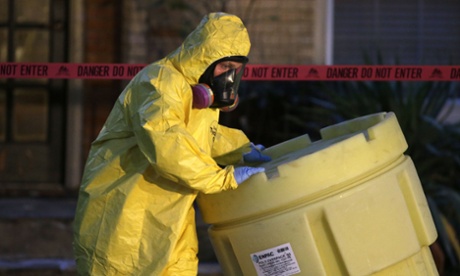It is not yet clear how Nina Pham became infected with deadly virus, but CDC chief said it was likely breach of protocol

The revelation that a nurse who treated Thomas Eric Duncan in Dallas was diagnosed with Ebola after an apparent breach in protocols has cast doubts over whether US hospitals are adequately prepared to deal with the deadly virus.
It is not clear how the nurse became infected, but the director of the Centers for Disease Control and Prevention (CDC), Tom Frieden, said it was likely a breach in infection control protocol. The CDC is urgently reviewing whether its procedures are adequate.
“We need to rethink the way we address Ebola infection control because even a single infection is unacceptable,” Frieden said in a media briefing.
Federal health officials in Dallas are investigating the circumstances that led to the first case of Ebola transmission in the US. According to medical records, the nurse, Nina Pham, was among about 70 staff members at Texas Health Presbyterian Hospital who cared for Thomas Eric Duncan, a Liberian who contracted the disease before arriving in the US.
Frieden said on Monday that health officials will be on hand at the Dallas hospital to help workers remove their gear after leaving the isolation room where the nurse is being treated. The CDC is monitoring all hospital workers who treated Duncan and planned to “double down” on training and outreach on how to safely treat Ebola patients, Frieden said. He could not provide a number of health care workers under surveillance.

Duncan was the first Ebola patient treated at a hospital other than one of the nation’s four bio-containment units specially-equipped to handle patients with deadly, infectious diseases. He is also the first US Ebola patient to die from the disease. His death has raised questions over whether hospitals can appropriately care for such patients.
The director of the nation’s largest organization of nurses has said the nation’s hospitals are not ready.
“Nurses and other frontline hospital personnel must have the highest level of protective equipment, such as the hazmat suits Emory University or the CDC themselves use while transporting patients and hands-on training and drills for all RNs and other hospital personnel, that includes the practice putting on and taking off the optimal equipment,” RoseAnn DeMoro, executive director of National Nurses United, said in a statement on Sunday.
The union is calling on hospitals to provide nurses and hospital personnel with specialized training and to supply better protective equipment for those confronting sick patients.
Dr William Schaffner, an infectious disease specialist at Vanderbilt University Medical Center in Nashville, Tennessee, said health care workers are most at risk of infection when they remove their protective gear after leaving the isolated unit where patients are being treated.

He said the layers of protective clothing are hot, and after what can be hours, workers are eager to shed their gear: “You want to get out of this stuff,” he said. “The important thing is that you do it in the appropriate sequence and very deliberately.”
A careful sequence must be followed so that the contaminants on the gear are not transferred to the worker’s skin, Schaffner said. He said they train hospital staff at Vanderbilt to count to five as they remove each garment and enforce a “buddy system” to ensure the process is carried out appropriately.
“Taking off the equipment is the hazardous moment,” he said. “In Africa, they have buddies that watch you and slow you down while you do this, and we need to do that, also,with folks here.”
Some medical experts have called for all Ebola patients to be transferred to dedicated hospitals or specialty centers. Frieden said on Sunday the CDC was considering this as an option.
Even if this were the case, Schaffner said all hospitals still need to be prepared to treat Ebola patients. Given that there are only four units spread out across the US, a sick patient is more likely to turn up at another hospital. The hospital would have to be prepared to diagnose, isolate and stabilize the patient until transportation arrangements are made. And if the patient arrives in very bad condition, feverishly ill as Duncan did, transferring that person to another hospital may not be possible. At that point, the hospital would be required to treat that person on site.
The units feature high-level air filters to keep germs from spreading beyond the isolated room, a “dunk tank” for handling lab specimens and a large sterilizer called an autoclave to accommodate medical waste before it’s transported. Perhaps most importantly, the units are staffed with highly-trained health care professionals who are drilled numerous times throughout the year.

The five American Ebola patients who were repatriated after contracting the virus in west Africa were transported and treated at one of the bio-containment units. Three have made full recoveries, one has said on Twitter he feels better, and the fifth has requested anonymity but as of late last week was still receiving care in hospital.
The diagnosis of an American nurse is a sobering reminder of the risks health care workers take when treating patients suffering from the deadly disease. As of last week, nearly 420 health care workers had contracted Ebola, and more than half died from the infection, according to the World Health Organization (WHO).
Frieden said on Monday that federal health officials are investigating the apparent breach in infection control procedures, and warned more cases could emerge.
“We need to consider the possibility that there could be additional cases, particularly among the health care workers who cared for the index patient when he was so ill,” Frieden said.
